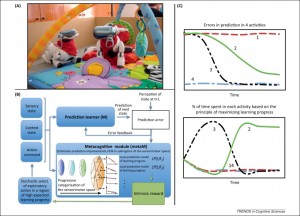Flowers Laboratory
FLOWing Epigenetic Robots and Systems
Information-seeking, curiosity, and attention: computational and neural mechanisms
We just published a milestone article on information seeking, curiosity and attention in human brains and robots, in Trends in Cognitive Science. This is the result of our ongoing collaboration with Jacqueline Gottlieb and her Cognitive Neuroscience Lab at Columbia University, NY (in the context of the Inria associated team project “Neurocuriosity”).
Information Seeking, Curiosity and Attention: Computational and Neural Mechanisms
Gottlieb, J., Oudeyer, P-Y., Lopes, M., Baranes, A. (2013)
Trends in Cognitive Science, 17(11), pp. 585-596. http://dx.doi.org/10.1016/j.tics.2013.09.001 Bibtex Pdf preprint
Abstract:
Intelligent animals devote much time and energy to exploring and obtaining information, but the underlying mechanisms are poorly understood. We review recent developments on this topic that have emerged from the traditionally separate fields of machine learning, eye movements in natural behavior, and studies of curiosity in psychology and neuroscience. These studies show that exploration may be guided by a family of mecha- nisms that range from automatic biases toward novelty or surprise to systematic searches for learning progress and information gain in curiosity-driven behavior. In addition, eye movements reflect visual information searching in multiple conditions and are amenable for cellular-level investigations. This suggests that the ocu- lomotor system is an excellent model system for under- standing information-sampling mechanisms.
Highlights
• Information-seeking can be driven by extrinsic or intrinsic rewards.
• Curiosity may result from an intrinsic desire to reduce uncertainty.
• Curiosity-driven learning is evolutionarily useful and can self-organize development.
• Eye movements can provide an excellent model system for information-seeking.
• Computational and neural approaches converge to further our understanding of information-seeking.





